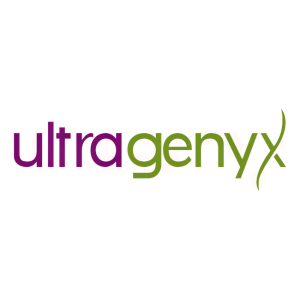Ultragenyx Announces First Patient Dosed in Aurora Study Evaluating GTX-102 in Additional Angelman Syndrome Genotypes and Age Groups
Rhea-AI Summary
Ultragenyx (NASDAQ: RARE) announced the first patient has been dosed in the Aurora study (NCT07157254) evaluating GTX-102 (apazunersen) in additional Angelman syndrome genotypes and age groups.
The global, open-label basket trial will enroll approximately 60 participants ages 1 to <65 across all genotypes, with four cohorts and a 48-week primary efficacy period; Cohort D uses a 2:1 randomization versus a No Treatment group that crosses over at Week 24. The fully enrolled Phase 3 Aspire study completed enrollment at 129 participants (ages 4–17) and Aspire data are expected in H2 2026.
Positive
- First patient dosed in Aurora study (GTX-102)
- Aurora expands treatment to all genotypes and ages 1 to <65
- Aspire Phase 3 enrollment completed early with 129 participants
- Aspire data expected in H2 2026
Negative
- Aurora planned enrollment is relatively small at ~60 participants
- No Treatment control in Cohort D crosses over at Week 24, limiting untreated comparison period
News Market Reaction 1 Alert
On the day this news was published, RARE gained 1.68%, reflecting a mild positive market reaction.
Data tracked by StockTitan Argus on the day of publication.
NOVATO, Calif., Oct. 30, 2025 (GLOBE NEWSWIRE) -- Ultragenyx Pharmaceutical Inc. (NASDAQ: RARE) today announced that the first patient has been dosed in the Aurora study (NCT07157254) evaluating the efficacy and safety of GTX-102 (apazunersen), an investigational antisense oligonucleotide (ASO) for Angelman syndrome (AS). Data from the Aurora study will expand the population of Angelman patients treated to include both younger and older patients and those with other non-deletion AS genotypes not included in the Phase 3 Aspire study. The fully enrolled Phase 3 Aspire study (NCT06617429) of GTX-102 is focused on patients aged 4 to 17 years with a genetically confirmed diagnosis of full maternal UBE3A gene deletion.
"The open-label basket design of the Aurora study will enable us to efficiently evaluate the safety and efficacy of GTX-102 in younger and older patients with Angelman syndrome and those with other genotypes," said Eric Crombez, M.D., chief medical officer at Ultragenyx. “While the Aspire study population represents the largest group of Angelman patients, we recognize the importance of bringing this potential new treatment to all patients, across genotypes and ages, as quickly as possible.”
Amanda Moore, chief executive officer at the Angelman Syndrome Foundation (ASF) and Ryan Fischer, chief operating officer at Foundation for Angelman Syndrome Therapeutics (FAST), added in a joint statement: "The launch of the Aurora trial marks an exciting and hopeful moment for the Angelman syndrome community. This study captures a broad spectrum of individuals living with Angelman syndrome and reflects a collective goal shared by our community—to ensure that clinical trial opportunities are available across ages and genotypes. We are grateful to Ultragenyx for their continued commitment to advancing research for our loved ones and for recognizing the importance of including a diverse population of individuals in clinical trials."
The global Aurora study will enroll approximately 60 participants ages 1 to < 65 with Angelman syndrome across all genotypes and will include some additional countries or regions that could not be included in the Aspire Phase 3 study. Participants will be assigned to one of four cohorts with corresponding subprotocols:
| Cohort | Age (years) | Genotype | Primary Endpoint |
| A | ≥ 1 to < 4 | Deletion-type AS | Bayley-4 cognitive raw score |
| B | ≥ 4 to <18 | Uniparental paternal disomy (UPD) and imprinting center defect (ICD) | Multi-domain Responder Index (MDRI) response |
| C | ≥ 18 to < 65 | All genotypes | MDRI response |
| D | ≥ 4 to < 18 | UBE3A gene mutation | MDRI response |
Cohorts A, B, and C are single-arm only and in Cohort D participants will be randomized 2:1 to a GTX-102 group or a No Treatment group. All cohorts have a 48-week primary efficacy period; the No Treatment group will cross over to treatment receive their first loading dose of GTX-102 at Week 24. Participants from all cohorts have the option to continue treatment in a long-term extension study following their Aurora end of study visit.
In July 2025, enrollment for the global Phase 3 Aspire study was completed ahead of plan due to patient and investigator interest, with 129 participants ages four to 17 with a genetically confirmed diagnosis of full maternal UBE3A gene deletion randomized across 28 global sites. Data from the Aspire study are expected in the second half of 2026.
About GTX-102 (apazunersen)
GTX-102 (apazunersen) is an investigational antisense oligonucleotide (ASO) therapy delivered via intrathecal administration and designed to target and inhibit expression of the UBE3A-AS to prevent silencing of the paternally inherited allele of the UBE3A gene and reactivate expression of the deficient protein. GTX-102 has been granted Breakthrough Therapy Designation, Orphan Drug Designation, Rare Pediatric Disease Designation, and Fast Track Designation from the FDA and Orphan Designation and PRIME designation from the EMA.
About Angelman Syndrome
Angelman syndrome is a rare, neurogenetic disorder caused by loss-of-function of the maternally inherited allele of the UBE3A gene. The maternal-specific inheritance pattern of Angelman syndrome is due to genomic imprinting of UBE3A in neurons of the central nervous system (CNS), a naturally occurring phenomenon in which the maternal UBE3A allele is expressed and the paternal UBE3A is not. Silencing of the paternal UBE3A allele is regulated by the UBE3A-AS, the intended target of GTX-102. In almost all cases of Angelman syndrome, the maternal UBE3A allele is either missing or mutated, resulting in limited to no protein expression. This condition is generally not inherited but instead occurs spontaneously. It is estimated to affect approximately 60,000 people in commercially accessible geographies.
Angelman syndrome is a lifelong neurodevelopmental disorder that causes cognitive impairment, motor impairment, balance issues, and debilitating seizures. Some individuals with Angelman syndrome are unable to walk and most do not speak. Anxiety and disturbed sleep can be serious challenges in individuals with Angelman syndrome. Although individuals with Angelman syndrome have a normal lifespan, they require continuous care and are unable to live independently. Angelman syndrome is not a degenerative disorder, but the loss of the UBE3A protein expression in neurons results in abnormal communications between neurons. Angelman syndrome is often misdiagnosed as autism or cerebral palsy. There are no currently approved therapies for Angelman syndrome; however, several symptoms of this disorder can be reversed in adult animal models of Angelman syndrome, suggesting that improvement of symptoms can potentially be achieved at any age.
About Ultragenyx
Ultragenyx is a biopharmaceutical company committed to bringing novel therapies to patients for the treatment of serious rare and ultra-rare genetic diseases. The company has built a diverse portfolio of approved medicines and treatment candidates aimed at addressing diseases with high unmet medical need and clear biology, for which there are typically no approved therapies treating the underlying disease.
The company is led by a management team experienced in the development and commercialization of rare disease therapeutics. Ultragenyx’s strategy is predicated upon time- and cost-efficient drug development, with the goal of delivering safe and effective therapies to patients with the utmost urgency.
For more information on Ultragenyx, please visit the company's website at: www.ultragenyx.com.
Forward-Looking Statements and Use of Digital Media
Except for the historical information contained herein, the matters set forth in this press release, including statements related to Ultragenyx's expectations and projections regarding its future operating results and financial performance, business plans and objectives for GTX-102, expectations regarding the tolerability and safety of GTX-102, anticipated timing of data from ongoing GTX-102 studies, anticipated timing for initiation and completion of GTX-102 studies, and future clinical and regulatory developments for GTX-102 are forward-looking statements within the meaning of the "safe harbor" provisions of the Private Securities Litigation Reform Act of 1995. Such forward-looking statements involve substantial risks and uncertainties that could cause our clinical development programs, collaboration with third parties, future results, performance or achievements to differ significantly from those expressed or implied by the forward-looking statements. Such risks and uncertainties include, among others, the uncertainty of clinical drug development and unpredictability and lengthy process for obtaining regulatory approvals, the ability of the company to successfully develop GTX-102, the company’s ability to achieve its projected development goals in its expected timeframes, the risk that results from earlier studies may not be predictive of future study results, risks related to adverse side effects, risks related to reliance on third party partners to conduct certain activities on the company’s behalf, smaller than anticipated market opportunities for the company’s products and product candidates, manufacturing risks, competition from other therapies or products, and other matters that could affect sufficiency of existing cash, cash equivalents and short-term investments to fund operations, the company’s future operating results and financial performance, the timing of clinical trial activities and reporting results from same, and the availability or commercial potential of Ultragenyx’s products and drug candidates. Ultragenyx undertakes no obligation to update or revise any forward-looking statements.
For a further description of the risks and uncertainties that could cause actual results to differ from those expressed in these forward-looking statements, as well as risks relating to the business of Ultragenyx in general, see Ultragenyx's Quarterly Report on Form 10-Q filed with the Securities and Exchange Commission (SEC) on August 6, 2025, and its subsequent periodic reports filed with the SEC.
In addition to its SEC filings, press releases and public conference calls, Ultragenyx uses its investor relations website and social media outlets to publish important information about the company, including information that may be deemed material to investors, and to comply with its disclosure obligations under Regulation FD. Financial and other information about Ultragenyx is routinely posted and is accessible on Ultragenyx’s Investor Relations website (https://ir.ultragenyx.com/) and LinkedIn website (https://www.linkedin.com/company/ultragenyx-pharmaceutical-inc-/).
Ultragenyx Contacts
Investors
Joshua Higa
ir@ultragenyx.com
Media
Jess Rowlands
media@ultragenyx.com







